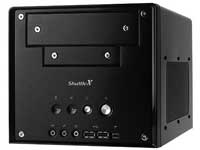Product Review:
Shuttle XPC SS56L
by Mitchell Levine
 Because
of the persistent attention that's been paid to the mobile
computing paradigm in education technology over the last
several years, a great deal of our editorial focus has been
centered on portable systems for some time. It's true that
those models have many valuable benefits, but it's also clear
that there's no “one size fits all solution” for
schools looking to reach their tech mandates.
Because
of the persistent attention that's been paid to the mobile
computing paradigm in education technology over the last
several years, a great deal of our editorial focus has been
centered on portable systems for some time. It's true that
those models have many valuable benefits, but it's also clear
that there's no “one size fits all solution” for
schools looking to reach their tech mandates.
Laptops have their advantages, but desktop component
models do as well: the latter are far more robust, upgradeable,
generally stable, cheaper, power efficient, and sometimes even
more feature-rich. Mobiles are also infamous for their heat
generation and cooling problems. In fact, if portability and
space aren't primary concerns, you're probably better off with
a desktop, especially in an education environment.
That said, most schools have good reason to desire
the advantages of mobile products. One of the largest of all
concerns in institutional procurement is space: districts with
the most need for technology access have the least room to
deploy them in. Is it possible to get the bonuses of the portable
form factor without the costs and liabilities?
Thanks to
Shuttle's latest entry in the market, the XPC SS56L that's
now within the realm of possibility. A highly compact unit,
the model's style is referred to with the designator SFF,
for “small form factor,” approximately
half the size of a typically equipped system. This is a bare-bones
package, so a monitor and CD-ROM drive are extra, but the additional
specs are impressive: A P4 CPU or a Celeron ranging from 400-800
Mhz; 400 MB DDR memory; support for hyper-threading; an 8x
AGP graphics system with 64MB of dedicated visual memory; and
240W SilentX power supply.
Beyond the
raw numbers, however, are a number of technologies and features
that promise great returns for the education user. The Integrated
Cooling Engine heat pipe technology keeps heat flows at a
functional level, while avoiding the exceedingly noisy standards
of most fan-based cooling solutions—very
important in an atmosphere where instructive communication
is paramount. Also superior is the design for airflow mechanics
within the product itself, something usually overlooked in
traditional manufacturing processes. Heat is the greatest enemy
of high technology, and for a community where maximum lifespan
is a supreme interest, this feature set should be a paramount
benefit.
Because of the extensive customizability options,
the curious reader should get further information from the
manufacturer's site, www.shuttle.com,
directly. For any institutional planner looking to derive desktop
performance from a system with a minimized footprint, especially
for multimedia use, when time spent configuring isn't a first
priority, the Shuttle XPC SS56L should be a serious consideration.#
